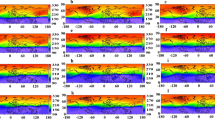Abstract
We compare our previously reported measurements of South Pole 225 GHz atmospheric opacity,τ, to the column of precipitable water vapor (PWV) which was derived from concurrent upper air soundings. From this comparison we found thatτ=(2.8±0.1)×10−2+(6.9±0.2)×10−2×PWV withτ in units of nepers/airmass andPWV in units of mm of precipitable H2O. We compared our results to predictions from Grossman's AT atmospheric transparency model which is widely used in the radio astronomy community. The coefficient of the second term of the above relation, 0.069, was consistent with the predictions from the model; however, the first term, 0.028, which represents the dry air opacity, was about five to ten times larger than expected. Most of this discrepancy between the observed and the predicted dry air opacity can be accounted for by including contributions from continuum emission from N2 and O2 as is done in Liebe's MPM atmospheric model.
Similar content being viewed by others
References
W. D. Smythe and B. V Jackson. Atmospheric water vapor at the South Pole.Applied Optics, 16(8):2041–2042, 1977.
B. L. Ulich. Improved correction for mm-wave atmospheric attenuation.Astrophysical Letters, 21:21–28, 1980.
C.C. Zammit and P.A.R. Ade. Zenith atmospheric attenuation measurements at millimetre and sub-millimeter wavelengths.Nature, 293:550, 1981.
E. Grossman. A T Program. Ver. 1.5, Air Head Software, 2069 Bluff St., Boulder, CO 80302, 1989.
H. J. Liebe. M P M — An atmospheric millimeter-wave propagation model.Int. J. IR and MM Waves, 10(6):631–650, 1989.
L. K. Emmons and R. L. DeZafra. Observation of a strong inverse temperature dependence for the opacity of atmospheric water vapor in the mm continuum near 280 GHz.Int. J. of IR and MM Waves, 11(4):469–488, 1990.
E. Serabyn; E. W. Weisstein; and D. C. Lis. FTS atmospheric transmission measurements and observations of planetary atmospheres. Presented at the 2nd Cologne-Zermatt Symposium, California Institute of Technology, 320-47, Pasadena, CA 91125.
R.A. Chamberlin and J. Bally. 225-GHz atmospheric opacity of the South Pole sky derived from continual radiometric measurements of the sky-brightness temperature.Applied Optics, 33(6):1095–1099, 1994.
Zhong-Yi Liu. 225GHz atmospheric reciever — user's manual. Electronics division internal report no. 271, NRAO, 1987.
Operations manual, system IS-4A1-Met, Version 2.03. Technical report, Atmospheric Instrumention Research, Inc., Boulder, CO, 1991. p. 50.
L. Savitz L. Potts. Humidity sensor equations. Tech. pub. no. 80415(c), VIZ Manufacturing Co., Philadelphia, PA, 1990.
R. R. Rogers.A Short Course In Cloud Physics, pages 17–18. Pergamon, 1976.
R. G. Gordon. On the pressure broadening of molecular multiplet spectra.J. Chem. Phy., 46(2):448–455, 1967.
K. S. Stankevich. Absorption of submillimeter-range radio waves in a dry atmosphere.Radiophys. Quantum Electron. Engl. Transl., 17:579–581, 1974.
P.W. Rosenkranz. Shape of the 5 mm oxygen band in the atmosphere.IEEE Trans. Antennas Propag., AP-23(4):498–506, 1975.
N.W.B. Stone; L.A.A. Read; A. Anderson; I.R. Dagg; and W. Smith. Temperature dependent collision-induced absorption in nitrogen.Can. J. Phys., 62:338–347, 1984.
H. J. Liebe. An updated model for millimeter wave propagation in moist air.Radio Science, 20(5):1069–1089, 1985.
S. Buehler; R. L. deZafra. Private communication, 1994. State University of New York, Stony Brook, NY.
Author information
Authors and Affiliations
Rights and permissions
About this article
Cite this article
Chamberlin, R.A., Bally, J. The observed relationship between the south pole 225-GHz atmospheric opacity and the water vapor column density. Int J Infrared Milli Waves 16, 907–920 (1995). https://doi.org/10.1007/BF02066665
Received:
Issue Date:
DOI: https://doi.org/10.1007/BF02066665




